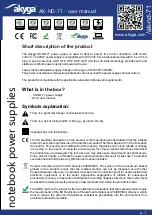
Safety Precautions
WARNING:
As with all machinery, there are certain hazards involved with their operation
and use. Exercising respect and caution will considerably lessen the risk of
personal injury. However, if normal safety precautions are overlooked or
ignored, personal injury to the operator or damage to property, may result.
1.
ALWAYS Learn the tools applications, limitations and the specific potential hazards
peculiar to it. Read and become familiar with the entire operating manual.
2.
ALWAYS check for damage. Before using the tool, any damaged part, should be
checked to ensure that it will operate properly, and
perform its intended function. Check for alignment of
moving parts, breakage of parts, mountings, and any
other condition that may affect the tools operation. Any
damage should be properly repaired or the part replaced.
If in doubt, DO NOT use. Consult your local dealer.
3.
ALWAYS wear safety goggles, manufactured to the latest
European Safety Standards. Everyday eyeglasses do not
have impact resistant lenses, they are not safety glasses.
4.
ALWAYS keep work area clean. Cluttered areas and benches
invite accidents.
5.
ALWAYS ensure that adequate lighting is available. A minimum
intensity of 300 lux should be provided. Ensure that lighting is
placed so that you will not be working in your own shadow.
6.
ALWAYS keep children away. All visitors should be kept a safe
distance from the work area, especially whilst operating the
tool.
7.
ALWAYS maintain tools in top condition. Keep them clean for the best and safest
performance.
8.
ALWAYS handle with extreme care do not carry the
tool by its electric cable, or yank the cable to
disconnect it from the power supply.
9.
ALWAYS concentrate on the job in hand, no matter
how trivial it may seem. Be aware that accidents are
caused by carelessness due to familiarity.
13. ALWAYS keep your proper footing and balance at all
times - dont overreach. For best footing, wear rubber
soled footwear. Keep floor clear of oil, scrap wood, etc.
Position 1:
straight grip for use as a standard driver.
Position 2:
pistol grip for hard to reach places.
To change from straight to pistol grip, simply hold the driver in both hands and fold until
handle clicks into position, to revert back to straight grip reverse the action.
Charging
Only ever use the charger supplied to charge the driver battery.
Before using for the first time, fully charge the battery (10 hours), subsequent charging time
will be reduced to approx 5 hours
To do this, connect the charger lead into the charger input on the underside of the driver
Fig. 3.
Plug the AC charger into a standard domestic 13amp socket and switch ON, the charging
indicator should illuminate to signify charging in progress.
Fig. 1
Fig. 2
Fig. 3
Charger Input
Charging indicator
IMPORTANT
never leave the driver on charge for more than 24 hours.
Always remove the charger from the main electric supply when not in use.
Operation
Select and insert the required bit into the driver, forward driving, push down on the
right hand side of the switch, and reverse push down on the left hand side.
With the switch released the drive shaft is automatically locked, enabling the possibility
to use as a standard screwdriver for final tightening or releasing tight screws.
DO NOT
attempt to use the driver whilst on charge.
-3-
-4-






















